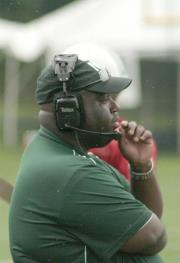By Kevin Loney
Head Football Coach
Nichols College (MA)

I’m truly honored to be able to write an article like this for my peer coaches. These game-planning philosophies are a product of a number of stops along my coaching career and a lot of trial and error. Thankfully, I’ve been blessed to spend time at all three levels of NCAA college football, and I’ve had the distinct honor to learn at the feet of some of the game’s best. Through all of this, I‘ve learned that the most important reality is that at the end of the day, football games are won by players, rather than schemes.
Step 1: Evaluate Talent
With that in mind, I firmly believe that the even before we can put our marker on the grease board, our first responsibility of coaching is to be able to objectively evaluate talent. We must figure out objectively what our players can & can’t do. We must also be able to assess objectively what the opposition’s guys can & can’t do. What are the match-ups? Where are the mismatches? How can we exploit our pluses? How can we hide or protect our minuses?
Next, we must figure out what do our guys need to do to improve their weaknesses. Then we must ask ourselves, "can we get it taught and how long will it take?" For example, I was blessed to spend two seasons at the University of Notre Dame as an intern and a Grad Assistant with the Offensive Staff under Coach Charlie Weis. After the 2007 season, we took the time to go through each snap of the season and evaluate our scheme, what did we do well, and what did we struggle with. We had a protection called 64 Scan. It was a pretty in depth protection concept and we as a staff felt that after watching it we should de-emphasize it in our playbook. After listening to us, Coach Weis felt that it was a concept that we would need in 2008. Our job was to take almost our entire spring and training camp practices to get it re-taught and practiced enough that it would not be a liability. After all that work and practice time, it went from being our worst protection to one of our best.
Step 2: Establish Philosophy
Once you have evaluated your talent, you can begin to establish a defensive philosophy. Here at Nichols, we start with a few simple premises:
- First, we believe that we must dominate 1st down and first and possession & 10 snaps.
- We want to get the offense off schedule, which means putting them in long 2nd downs which we believe lead to low percentage 3rd downs, which lead to punts. We coach our players that it is the job of the defense to take points off the board.
- We must turn TD’s into FG’s, turn FG’s into long FG’s or failed 4th down attempts, and finally force punts instead of FG’s.
Step 3: Come Up With Answers
Our coaching staff believes that at the end of the day, it’s our job as coaches to have and create answers to the challenges presented by the opposing offense. We take time during off-season as a staff to come up with answers to the things we don’t see often. For us, it’s the Triple Option, Wing-T, Spread, and Pistol offenses. For High School coaches, it may be the Single wing, or the Double Wing. I challenge my offensive staff to do the same with defenses they don’t see often like the 3-4, 3-3 and various types of zone pressures. Once we’ve put our answers to these issues together, we try to use late pre-season practices and possibly spring to introduce these answers to our players, we don’t think that the first time they see them should be in preparation for the game.









